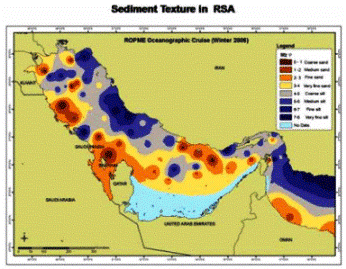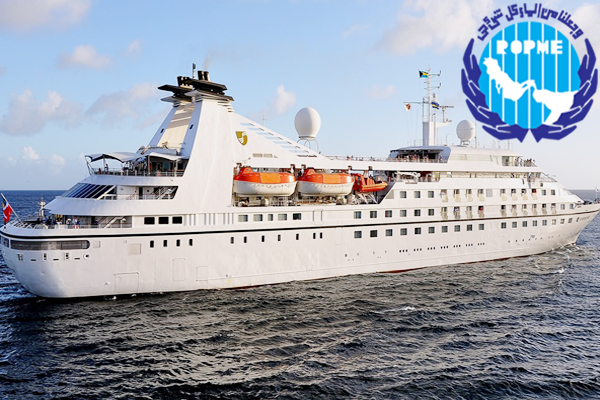
Periodical assessment of the state of marine environment in the whole ROPME Sea Area (RSA) was and still a major task in the ROPME Regional Action Plan, under the umbrella of the Kuwait Convention.
For the assessment of the open sea area of RSA, five Oceanographic Cruises have been conducted during the last 2 decades, beginning from the Mt. Mitchell Cruise in 1992 and the last being winter 2006 Cruise. Following is a summary of objectives and achievements for each Cruise:
Mt. Mitchell Cruise (1992)
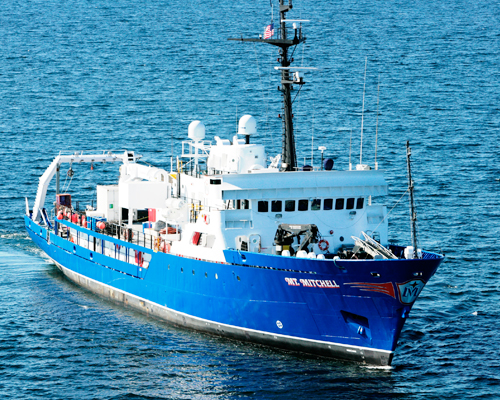
Date: June 1992 (RSA & Sea of Oman)
Vessel: R/V Mt Mitchell (NOAA-USA)
Sponsors: NOAA, UNESCO-IOC, UNEP and ROPME
Objective: Comprehensive assessment of the impacts on the Marine environment of RSA, caused due to the massive oil spills and oil well fires during 1990-91 Iraqi invasion of Kuwait.
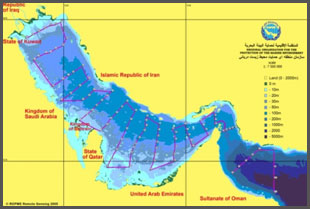
Mt. Mitchell Cruise was conducted in the wake of the large Regional disturbance that occurred during the Iraqi invasion of Kuwait in1990-91. This Cruise was a landmark expedition in many ways and was the first collective effort that gave rise to a series of Cruises later.
The 100-days expedition that occurred between February and June 1992 focused the attention of many of the world’s marine scientists on the environmental aftermath of the War.
It was an extraordinary undertaking, involving the combined efforts of hundreds of Regional and International researchers in the ROPME Region.
Beside the standard oceanographic investigations, the Cruise involved a broad range of other specific investigations including the assessment of impact of oil spills in off and near shore environments, Regional circulation and sedimentation of spilled oils on coral reefs and seafood quality.
It is believed that the all objectives of Mt. Mitchell mission were accomplished. However the full significance of it may not be known for some time.
The first findings and scientific results from the expedition had been presented during an international Workshop held in the State of Kuwait in January 1993.The full scientific outcome of this expedition has been published in a special issue of Marine Pollution Bulletin in 1995.
One important contribution of the Mt. Mitchell Cruise was the establishment of 106 reference sampling sites, widely distributed in the ROPME Sea Area, which were meticulously followed in all the later Cruises as well.
Umitaka-Maru Cruises (1993-1994)
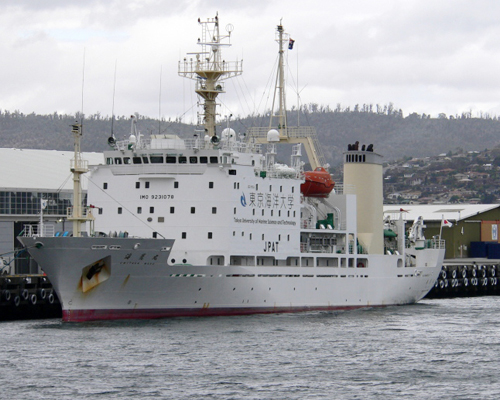
Dates: Dec. 1993, Jan. 1994 and Dec. 1994 (Inner RSA)
Vessel: RT/V Umitaka-Maru (Tokyo University of Fisheries -Japan)
Sponsors: ROPME, UNEP, IOC, JAPAN
Objective: Studying the roles of large-scale dynamics of physical, chemical and biological processes in RSA for the distribution, fate and flux of pollutants among different ecosystems following the 1990-91 War.

Surveyed Stations During Umitaka-Maru Cruises These three short Cruises of 12 days each were planned and conducted under the umbrella of ROPME, UNEP and IOC for the implementation of an Integrated Action Plan for the RSA to assess the impact of War and to improve knowledge on relevant Regional environmental factors.
The oceanographic programme of the Cruises included:
- Defining baroclinic structure and water mass analysis
- Investigation of localized physical processes to define exchange and sub-synoptic-scale current pattern in the Strait of Hormuz.
- Determination of petroleum hydrocarbon loading by sediment.
- Biodegradation of hydrocarbons by benthic community and microbes.
- Water chemical analyses and biological investigation.
- Survey of hard-bottom coral areas.
- Analysis of commercial marine species.
The scientific results from these cruises have been presented in an International Symposium , held in the State of Kuwait in Dec.1995 and published in a book in 1998 entitled : Offshore Environment of ROPME Sea Area after the War- Related oil Spill.
ROPME Oceanographic Cruise – Summer 2000
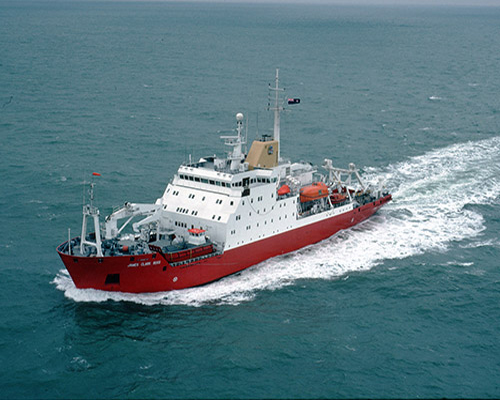
Date: 14 Aug – 4 Sept. 2000 (N. RSA)
Vessel: T/V Ghods – I.R.Iran
Sponsors: ROPME and DOE (I. R. Iran)
Objectives: Assessment of main prevailing physical, chemical, biological and bottom sediment features in Northern RSA during summer season.
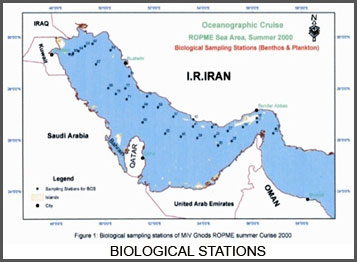

This Cruise was organized for the continuous monitoring and assessment of the obvious degradation in the marine environment of the RSA following to the War represented by and the observed catastrophic fish kill incident of September-October 1999 in Kuwaiti and Iranian waters. The scientific plan of the Cruise included also the assessment of ecological consequences from the drainage of Marshlands of Mesopotamia in Iraq. However, the Cruise activity was confined to the Iranian waters up to the median line of Inner RSA including Strait of Hormuz, Shatt Al- Arab and Kuwaiti waters.
Different marine samples were collected and studies included the assessment of biodiversity, hydrography, physio-chemical analysis, contaminants in surface and core sediments and radioactivity.
The results from this cruise were presented in Regional Meeting of experts and published in technical reports.
ROPME Oceanographic Cruise – Summer 2001
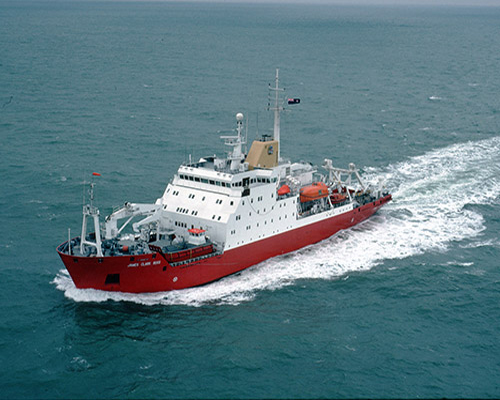
Date: 6- 27 Aug. 2001 (Inner RSA)
Vessel: T/V Ghods- I.R.Iran
Sponsors: ROPME and DOE (I. R. Iran)
Objectives: General oceanographic studies (physical, chemical, biological), contaminants in sediments and recording of prevailed hydrography and meteorology in RSA during summer season
Since the investigation and planned studies for the whole RSA during summer season couldn’t be achieved during summer 2000 Cruise, it was decided to organize this cruise during the following summer of 2001.
Along 15 transects, 83 stations were monitored and sampled as required in the Cruise scientific plan. Because of special circumstances, the Outer RSA stations in the Sea of Oman couldn’t be sampled.
Besides the measurements of hydrological and meteorological parameters along the Cruise track, water and sediment samples were collected for:
- Chemical analyses of nutrient salts, chlorophyll
- Biological investigation of phytoplankton, zooplankton and bacterioplankton
- Meiofauna and machrofauna in sediment
- Organic matter in sediment and grain size analysis
- Levels of inorganic and organic contaminants in sediment
The collected samples were distributed among specialized laboratories in the Region for analysis. It is planned to publish the results by ROPME Secretariat in a series technical reports.
ROPME Oceanographic Cruise – Winter 2006
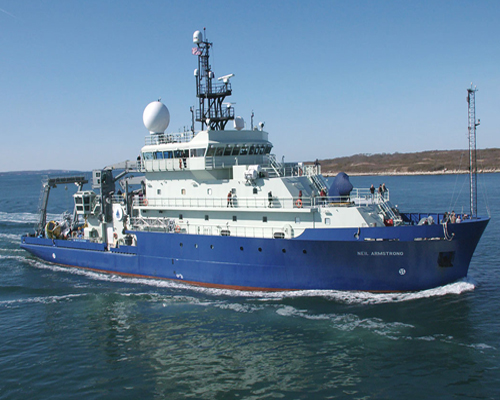
Date: 1 Feb – 11 Mar 2006 (RSA and Sea of Oman)
Vessel: T/V Ghods- I.R.Iran
Sponsors: ROPME and DOE (I. R. Iran)
Objectives: Comprehensive Oceanographic Study for the assessment of prevailed marine and meteorological features in the whole RSA during winter season.
This Cruise can be fairly considered as a significant stage to the Regional monitoring performance and as an added value to the world of oceanography.
It was planned and achieved taking into account the obstacles faced in the previously organized Cruises and accomplished depending on thinking, planning and proceeding by existing facilities and expertise from the Region.
Totally, more than one hundred scientists and specialists have participated during the three legs of the Cruise.
For increasing the performance during the cruise and magnifying the benefits from the Cruise, a Regional Task Force was formulated from reputed marine scientists from the Region to plan the Cruise scientific programme and to follow upon the implementation. The Task Force started the identification of Cruise targets as follows:
- To gather oceanographic data, to be construed as a representation of the prevailing season, for characterizing physicochemical properties of the water masses in the RSA;
- To Collect samples of the water column and seabed sediments for the determination of nutrient concentrations and distribution, possibly including impact analysis and source apportionment, whenever possible;
- To obtain widespread sediment samples for determining the seasonal concentration and distribution of the oil and non-oil pollutants within the RSA, especially – persistent toxic substances such as total petroleum hydrocarbons (TPHs) and other by-products including polycyclic aromatic hydrocarbons (PAHs), heavy metals, organochlorinated pesticides, and polychlorinated biphenyls (PCBs);
- To observe the dominant winter composition, abundance, and biomass of the phytoplankton, zooplankton, and Ichthyoplankton through standard net tows and multi-bottle sampling; and
- To elucidate the winter community structure of Macrobenthos, meiobenthos, and cysts based on their observed biodiversity and abundance in sediments.
To achieve the targets of the Cruise within high quality performance , the Cruise Task Force elaborated three Management Plans.
About 5000 of water, sediment and biological samples were collected during the Cruise as required by the scientific plan for carrying out analysis and investigations relevant to different disciplines. Type and total number of collected samples are grouped leg wise in the following table:
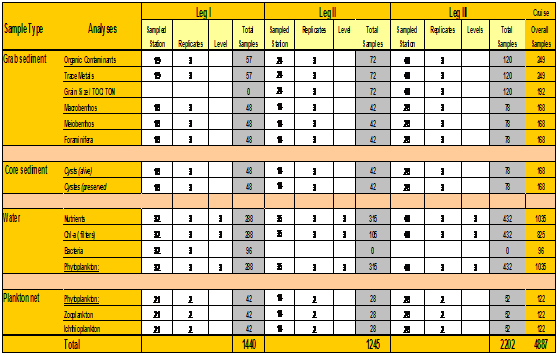
One of principal objectives of the Cruise was to extend opportunity for conducting the analysis of collected samples among specialized National Research Institutions in the Region. Towards this, a series of proficiency were conducted between willing laboratories to designate the most proficient laboratory to conduct samples analysis in each discipline.
Subsequently, ROPME Secretariat received the following final reports on the analytical and investigation results of each discipline:
- Hydrography and meteorology in the ROPME Sea Area during the ROPME Winter 2006 Oceanographic Cruise in comparison with the results of Cruises 2000 and 2001
- Pollutants in surface sediments and geochemistry of sea bed
- Nutrient salts in sea water
- Analysis of Phytoplankton and Chlorophyll-a samples
- Analysis of Zooplankton samples
- Analysis of Ichthyoplankton and Decapod Larvae samples
- Meiobenthic community structure in ROPME Sea Area during the ROPME Winter 2006 Oceanographic Cruise in comparison with the results of Cruises 2000 and 2001
- Analysis of macrobenthos samples
- Analysis of Foraminifera samples
- Preliminary Assessment of Radionuclides in marine sediments
Recently, the Regional Cruise Task Force held a meeting with the following objectives:
- Discussion of the results of different disciplines
- Standardization of interpretation of results
- Result validation and data management
- Integration of results
- Evaluation of results
- Standardization of biotic monograph format
- Publication of results
- Identification of gaps in knowledge and future need
- Future course of action
The Task Force recommended to organize an International Conference to present the ROPME winter 2006 Cruise along with previous ROPME Cruises and any other oceanographic activities in the RSA. Tentatively, it is planned to hold this conference in one of the ROPME Member States during mid 2011.
